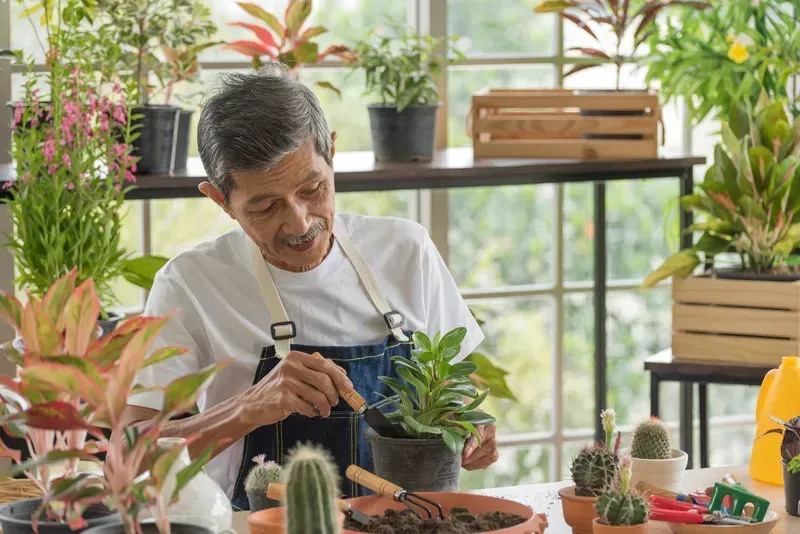BLOG
Gardening for Seniors: Benefits and Accessible Gardening Ideas in Assisted Living
Gardening offers numerous benefits for seniors, particularly those residing in assisted living communities. Engaging in gardening activities provides physical exercise, mental stimulation, and opportunities for social interaction. The fresh air and connection to nature further enhance overall well-being. Incorporating accessible gardening ideas ensures that all seniors, regardless of mobility levels, can participate and reap these benefits.
Assisted living communities that integrate gardening into their programs create enriching environments for residents. By tailoring gardening activities to meet the needs of seniors, these communities promote active lifestyles and improve quality of life.
1. Physical Benefits of Gardening for Seniors
Gardening is a low-impact physical activity that enhances strength, flexibility, and endurance. Tasks such as planting, weeding, and watering involve various muscle groups, promoting overall fitness. Regular physical activity through gardening can help manage weight, reduce the risk of chronic diseases, and improve cardiovascular health. According to a study, gardening has strong physical health benefits for older adults.
Engaging in gardening also improves hand-eye coordination and fine motor skills. Handling tools and plants requires precision, which can enhance dexterity. Maintaining motor skills is crucial for daily activities and contributes to sustained independence. Moreover, the physical exertion involved in gardening can lead to better sleep patterns, further benefiting overall health.
Exposure to sunlight during gardening increases vitamin D levels, which are essential for bone health. Adequate vitamin D helps prevent osteoporosis and fractures, which are common concerns among seniors. However, to reduce the risk of skin cancer, it's important to balance sun exposure with skin protection. Wearing appropriate clothing and sunscreen can mitigate these risks.
The right gardening ideas also encourage functional movement, such as bending and stretching, which enhance flexibility. These movements can alleviate stiffness and improve joint health. Maintaining flexibility is vital for comfortably performing daily tasks. Furthermore, the weight-bearing aspects of gardening activities help strengthen bones and muscles.
Gardening can also be a form of aerobic exercise. Activities like raking and digging elevate heart rates, promoting cardiovascular fitness. This aerobic component contributes to overall stamina and energy levels. Incorporating regular gardening sessions into routines can lead to long-term health benefits.
2. Mental and Emotional Benefits
Gardening has been linked to improved mental health, reducing symptoms of depression and anxiety. Nurturing plants provides a sense of purpose and accomplishment. Engaging with nature has a calming effect, lowering stress levels and promoting relaxation. According to experts, gardening has been scientifically proven to improve both mental and physical health, contributing to a longer and happier life.
Gardening activities stimulate the brain through sensory experiences such as touching soil and smelling flowers. These stimuli can evoke positive memories and emotions, which is particularly beneficial for seniors with dementia. Gardening activities also encourage mindfulness, keeping individuals present and engaged. This focus can distract from negative thoughts and improve mood.

Learning about different plants and gardening techniques provides mental stimulation. This continuous learning keeps the brain active, potentially delaying cognitive decline. Setting and achieving gardening goals, like growing a new plant, fosters a sense of achievement. This accomplishment boosts self-esteem and confidence.
Gardening also offers creative outlets, allowing seniors to express themselves through garden design. Choosing plant colors, layouts, and themes engages artistic skills. This creativity can lead to increased satisfaction and joy. Moreover, the unpredictability of gardening, such as weather changes, teaches adaptability and resilience.
Social aspects of gardening, like sharing produce or discussing techniques, enhance emotional well-being. These interactions build community and reduce feelings of loneliness. Participating in group gardening projects fosters teamwork and a sense of belonging. This camaraderie is essential for mental health and happiness.
3. Social Benefits and Community Engagement
Gardening in a community setting fosters social connections among residents. Collaborative projects, like community gardens, encourage teamwork and communication. These interactions can lead to lasting friendships and a supportive network. Social engagement is crucial for mental health, reducing feelings of isolation.
Sharing gardening experiences and knowledge promotes a sense of community. Residents can bond over common interests, strengthening relationships. Organizing gardening clubs or workshops provides structured social opportunities. These activities can become regular social events, enhancing community cohesion.
Gardening also offers intergenerational engagement opportunities. Inviting family members, including grandchildren, to participate can bridge age gaps. These shared activities create meaningful experiences and memories, enriching the lives of both seniors and younger participants.
Participating in local gardening competitions or farmers' markets connects residents to the broader community. Showcasing their work provides recognition and pride. These events encourage residents to engage beyond the assisted living community, enhancing a sense of purpose and belonging.
Gardening can also lead to volunteer opportunities, such as maintaining public gardens. These activities allow residents to contribute positively to society. Volunteering fosters a sense of accomplishment and altruism. Engaging in meaningful work benefits both the community and individual well-being.
Accessible Gardening Ideas for Seniors
Implementing accessible gardening ideas ensures that all seniors can participate, regardless of physical limitations. Raised garden beds reduce the need for bending, making planting and harvesting easier. Container gardening allows residents to grow plants on patios or balconies. These modifications create an inclusive gardening experience for all mobility levels.
Vertical gardens are another excellent option for assisted living communities. Wall-mounted planters or trellises allow seniors to grow flowers, herbs, or vegetables at an accessible height. This method saves space while keeping plants within easy reach. Lightweight containers and ergonomic tools further enhance comfort.

Adaptive gardening tools can help seniors with arthritis or limited dexterity. Tools with padded grips, extended handles, and lightweight designs reduce joint strain. Kneeling benches with handles provide stability when working close to the ground. These adjustments make gardening safer and more enjoyable.
Automated watering systems simplify plant care for seniors with limited mobility. Drip irrigation or self-watering containers reduce the need for frequent watering, ensuring plants receive consistent moisture while minimizing physical effort. Timed irrigation systems also prevent overwatering.
Sensory gardens can provide a therapeutic experience for seniors in assisted living. Fragrant flowers, textured plants, and calming sounds enhance the gardening experience. Raised beds with various herbs like lavender and mint stimulate the senses. This approach makes gardening engaging and beneficial for overall well-being.
Choosing the Right Plants for Senior-Friendly Gardens
Selecting low-maintenance plants ensures a rewarding gardening experience for seniors. Hardy perennials like lavender, coneflowers, and hostas require minimal care while providing beautiful blooms. Native plants adapt well to local conditions and require less watering. These options reduce maintenance while keeping gardens vibrant.
Edible plants offer both nutritional and therapeutic benefits. Herbs like basil, thyme, and rosemary are easy to grow and can enhance meals. Small vegetable plants like cherry tomatoes and lettuce thrive in containers. Growing food fosters a sense of accomplishment and promotes healthy eating.
Pollinator-friendly plants support local wildlife while beautifying outdoor spaces. Flowers like zinnias, sunflowers, and bee balm attract butterflies and bees. Watching pollinators in the garden can be a calming and enjoyable activity. These plants also contribute to environmental conservation efforts.
Drought-tolerant plants reduce watering demands and simplify care routines. Succulents, ornamental grasses, and daylilies thrive in various conditions. These choices ensure a lush garden with minimal effort. Assisted living communities can incorporate these plants to maintain sustainable landscapes.
Fragrant flowers enhance the sensory experience for seniors. Roses, jasmine, and gardenias provide a delightful aroma that promotes relaxation. Strongly scented plants can also trigger positive memories. Including these flowers in garden designs creates a soothing environment for residents.
Try These Gardening Ideas in Assisted Living
Gardening allows seniors to stay physically active, mentally engaged, and socially connected. Assisted living communities that incorporate accessible gardening ideas create enriching environments for residents. Thoughtful garden designs and adaptive tools ensure that all seniors can participate. Encouraging a long-term gardening routine fosters a sense of accomplishment and joy.
At Assured Senior Living, residents benefit from personalized care and engaging activities, including gardening programs tailored to their needs. Thoughtfully designed outdoor spaces provide opportunities for relaxation and connection with nature. Contact Assured Senior Living today to learn how their assisted living communities promote a fulfilling and active lifestyle.














